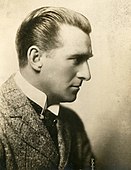The Right to Be Happy
| The Right to Be Happy | |
|---|---|
 The Moving Picture World Ad | |
| Directed by | Rupert Julian |
| Screenplay by | Elliott J. Clawson |
| Based on | A Christmas Carol by Charles Dickens |
| Starring | |
| Cinematography | Stephen Rounds |
Production company | Bluebird Photoplays |
| Distributed by | Universal |
Release date |
|
Running time | 5 reels (est. 55 minutes) |
| Country | United States |
| Language | Silent (English intertitles |
The Right to Be Happy is a 1916 American silent Christmas fantasy film directed by Rupert Julian. The film is based on the 1843 novella A Christmas Carol by Charles Dickens. The movie stars Rupert Julian as Ebenezer Scrooge and Claire McDowell as Mrs. Cratchit.
The Bluebird photoplay was produced by Universal and released on December 25, 1916.[1][2]
Plot[]
The film is a retelling of Charles Dickens' A Christmas Carol, recounting the story of Ebenezer Scrooge, played by Rupert Julian. Scrooge is an elderly miser and curmudgeon. Alone in his room on Christmas Eve, he is visited by the ghost of his former business partner Jacob Marley portrayed by Harry Carter. Marley’s ghost tells Scrooge three spirits will visit him over the next three nights.
Scrooge's first visit is by the Ghost of Christmas Past played by Wadsworth Harris. The Ghost shows Scrooge's development from a young boy to a young man. He sees how he started to become a miser.
Then, the Ghost of Christmas Present played by Richard L'Estrange appears, who shows Scrooge how the Cratchit family has fared. He finds out, unless the future changes, the Cratchit's disabled son, Tiny Tim featuring (Frankie Lee), will die.
The last spirit Scrooge meets is The Ghost of the Future played by (Tom Figee). This figure shows Scrooge scenes of people discussing someone's death. Nobody in the room seems concerned about the dead person. Scrooge doesn't know who the dead man is. Then, he finds out Tiny Tim has also passed. Next, Scrooge discovers he is the man whose death is celebrated.
He vows to change his ways and become a new person. Finally, Scrooge wakes up at home and finds out all the spiritual visits had happened during Christmas Eve. He also finds out today is Christmas Day.
Each visit positively changed Scrooge; he transforms into a kinder, gentler man full of Christmas spirit.
Cast[]
Actor Role Rupert Julian Ebenezer Scrooge John Cook Bob Cratchit Claire McDowell Mrs. Cratchit Frankie Lee Tiny Tim Harry Carter Jacob Marley Emory Johnson Fred, Scrooge's Nephew Francelia Billington Scrooge's Sweetheart Lydia Yeamans Titus Mrs. Fezziwig Wadsworth Harris Ghost of Christmas Past Richard L'Estrange Ghost of Christmas Present Tom Figee The Ghost of the Future Roberta Wilson Caroline
Preservation status[a][]
According to the Library of Congress website, this film has a current status of “No holdings located in archives,” thus it is presumed all copies of this film are lost.[3]
Gallery[]

 Francelia Billington in 1914
Francelia Billington in 1914
Scrooge's Sweetheart Emory Johnson in 1916
Emory Johnson in 1916
Fred, Scrooge's Nephew Frankie Lee in 1919
Frankie Lee in 1919
Tiny Tim Harry Carter in 1920
Harry Carter in 1920
Jacob Marley Claire McDowell
Claire McDowell
Mrs. Cratchit- Lydia Yeamans Titus
Mrs. Fezziwig
Notes[]
- ^
Film is history. With every foot of film that is lost, we lose a link to our culture, to the world around us, to each other, and to ourselves.[4]
Martin Scorsese
filmmaker, director NFPF BoardA report created by film historian and archivist David Pierce for the Library of Congress claims:
- 75% of original silent-era films have perished.
- 14% of the 10,919 silent films released by major studios exist in their original 35mm or other formats.
- 11% survive in full-length foreign versions or on film formats of lesser image quality.[5][6]
Many silent-era films did not survive for various reasons, as explained in the Wikipedia page on the subject.
References[]
- ^ The Right to Be Happy at the American Film Institute Catalog
- ^ The Right to Be Happy at the TCM Movie Database
- ^ "The Right to Be Happy / Rupert Julian [motion picture]". www.loc.gov/film-and-videos/.
- ^ "Preservation Basics". filmpreservation.org. Retrieved December 16, 2020.
Movies have documented America for more than one hundred years
- ^ Pierce, David. "The Survival of American Silent Films: 1912-1929" (PDF). Library Of Congress. Council on Library and Information Resources and the Library of Congress. Retrieved November 18, 2020.
- ^ Slide, Anthony (2000). Nitrate Won't Wait: History of Film Preservation in the United States. McFarland. p. 5. ISBN 978-0786408368. Retrieved March 25, 2013.
It is often claimed that 75 percent of all American silent films are gone and 50 percent of all films made prior to 1950 are lost, but such figures, as archivists admit in private, were thought up on the spur of the moment, without statistical information to back them up.
External links[]
| Wikimedia Commons has media related to The Right to Be Happy. |
- The Right to Be Happy at IMDb
- The Right to Be Happy at AllMovie
- "The Right to Be Happy". www.silentera.com. Retrieved June 5, 2021.
- 1916 films
- 1916 drama films
- 1916 lost films
- American films
- American black-and-white films
- American Christmas films
- American silent feature films
- Films based on A Christmas Carol
- Films directed by Rupert Julian
- Lost American films
- Silent films
- Universal Pictures films







